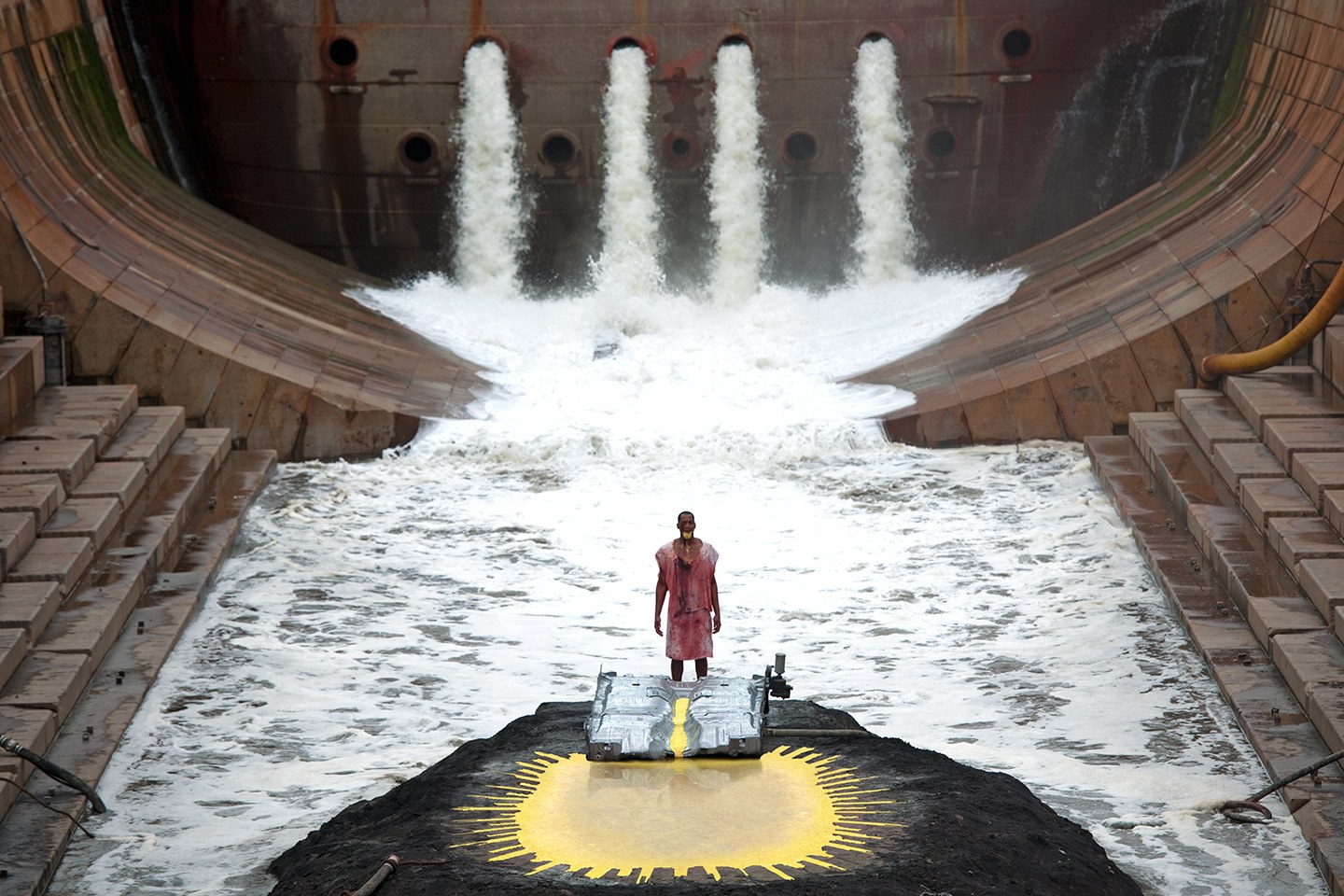
Scene at a drydock at the Brooklyn Navy Yard in Act III of Mathew Barney & Joanthan Bepler’s “River of Fundament”
On a frigid February night, I made a pilgrimage to BAM (Brooklyn Academy of Music) to see the 6 hour epic of Mathew Barney‘s new film, River of Fundament, loosely based on the 1983 Norman Mailer novel, Ancient Evenings. In the Mailer’s novel, the protagonist, an ancient Egyptian named Menenhetet I seeks to reincarnate three times in the hope of achieving immortality. According to the BAM program note, River of Fundament “borrows its structure from Mailer’s text, corresponding to the seven stages the Egyptian soul undergoes in its journey toward new life.” Conceived as a nontraditional opera (with the music by Jonathan Bepler), the movie’s narrative (or whatever narrative might be) is driven mainly through the music that is percussive and meditative at the same time (also the most enjoyable element in the movie).
Much has been said about the overflowing of feces in Barney’s new movie (Review in Hyperallergic can be found here). To me, the obsession with feces seemed entirely superfluous, neither shocking nor interesting that seems to overshadow all other aspects of this uneven, extremely long, but cinematically beautiful film. To be fair to Barney, it is Norman Mailer who makes his protagonist swim through the river of feces before each reincarnations, although I do fault Barney for blind hero worshiping here (but perhaps that is the entire point of the enterprise).
The film begins with a lavish dinner party/wake of Norman Mailer attended by New York’s cultural luminaries in his meticulously recreated Brooklyn apartment (floating on a barge on East River, as we later find out). Next 6 hours, Mailer’s journey through three reincarnations are conflated with the story of Menenhetet, Egyptian myth of Osiris, and Barney’s own previous oeuvre (involving the 1967 Chrysler Imperial from Cremaster 3).
I found most scenes taking place at Mailer’s apartment extremely tedious and pretentious (including gratuitous scene of anal cunnilingus), made worse by many celebrity cameos. On the other hand, earlier recordings of live performances in Los Angeles (REN, 2008), Detroit (KHU, 2010) and New York (BA, 2013) were much livelier. In an era when even the biggest budget movies are made only with digital effects, the spectacle involving large crowd, destruction, fire and procession was refreshing even though the spectacles themselves were utterly empty and devoid of any understanding of contemporary urban cultures of any of the cities involved. Yet, these scenes seemed to echo the biggest MGM Studio production numbers in its hay day (such as the entrance of Cleopatra in 1963 movie Cleopatra). The film finally comes to a close in Idaho’s Sawtooth Mountain Range, in Redfish lake where the sockeye salmon make their annual journey from the Pacific Ocean as if to cleanse previous 5 1/2 hours of wallowing in feces.

Scene from Detroit in Act II of Mathew Barney & Jonathan Bepler’s “River of Fundament”
The experience of watching Barney’s movie was not unlike watching hyper violent blockbuster movies, where the machismo of the bloody spectacle co-mingles with highly sentimental nostalgia for lost causes or past glory. In the case of River of Fundament, after nearly 6 hours, you are left with the very empty and reductive idea how the destructive power of masculinity is the mythic source of all creativity, and how this power is debased in the modern world. In the end, through heroic actions of male geniuses like Mailer, Hemingway & Barney, you get the Hallmark Card version of natural rebirths.
 Kira Nam Greene’s work explores female sexuality, desire and control through figure and food still-life paintings, surrounded by complex patterns. Imbuing the feminist legacies of Pattern and Decoration Movement with transnational, multicultural motifs, Greene creates colorful paintings that are unique combinations of realism and abstraction, employing diverse media such as oil, acrylic, gouache, watercolor and colored pencil. Combining Pop Art tropes and transnationalism, she also examines the politics of food through the depiction of brand name food products, or junk food. Recently, Greene started a figurative painting series spurred by the 2016 Presidential Election, Women’s March, #metoo movement and ensuing crisis of conscience, this new body of work aspires to present the power of collective action by women.
Kira Nam Greene’s work explores female sexuality, desire and control through figure and food still-life paintings, surrounded by complex patterns. Imbuing the feminist legacies of Pattern and Decoration Movement with transnational, multicultural motifs, Greene creates colorful paintings that are unique combinations of realism and abstraction, employing diverse media such as oil, acrylic, gouache, watercolor and colored pencil. Combining Pop Art tropes and transnationalism, she also examines the politics of food through the depiction of brand name food products, or junk food. Recently, Greene started a figurative painting series spurred by the 2016 Presidential Election, Women’s March, #metoo movement and ensuing crisis of conscience, this new body of work aspires to present the power of collective action by women.